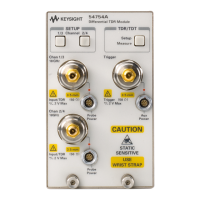Transmission Line Theory Applied to Digital Systems
Signal Propagation Delay for Microstrip and Strip Lines with Distributed or Lumped
Loads
11-15
Signal Propagation Delay for Microstrip and Strip Lines
with Distributed or Lumped Loads
The propagation delay, t
pd
, has been shown to be 1.77 ns/ft for microstrip lines
and 2.26 ns/ft for strip lines, when a glass epoxy dielectric is the surrounding
medium. The propagation delay time of the line will increase with gate loading
and the altered delay can be derived as follows. The unloaded propagation delay
for a transmission line is:
If a lumped load, C
d
, is placed along the line, then the propagation delay will be
modified to t’
pd
:
(11)
where L
o
and C
o
are the intrinsic line inductance and capacitance per unit
length.
Therefore, the signal propagation down the line will increase by the factor of:
A MECL gate input should be considered to have 5 pF of capacitance for ac
loading considerations (includes stray capacitance). If 4 gate loads are placed
on a 1 foot signal line, then the distributed capacitance, C
d
, is equal to 20 pF/ft
or 1.67 pF/in. As an example, a propagation delay increase is to be found for a
50 Ω microstrip line on a glass epoxy board. Given a line width of 25 mils, the
dielectric material would have a thickness of 15 mils to yield Z
o
= 50 Ω and a
capacitance of 35 pF/ft. Therefore, the modified propagation delay would be:
t
pd
L
o
C
o
=
t
′
pd
L
o
C
o
C
d
+
()
L
o
C
o
1
C
d
C
0
------+ t
pd
1
C
d
C
o
------+== =
1
C
d
C
o
------+
t
′
pd
1.77 ns/ft 1
20
35
------+2.21 ns/ft==

